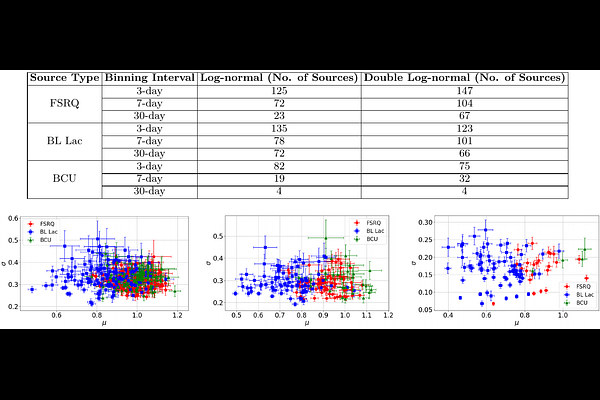Comprehensive Variability Analysis of Blazars Using Fermi Light Curves Across Multiple Timescales

Comprehensive Variability Analysis of Blazars Using Fermi Light Curves Across Multiple Timescales
Zahir Shah, Athar A. Dar, Sikandar Akbar, Anjum Peer, Zahoor Malik, Aaqib Manzoor, Sajad Ahanger, Javaid Tantry, Zeeshan Nazir, Debanjan Bose, Mushtaq Magray
AbstractIn this study, we conducted a systematic analysis of long-term Fermi-LAT \gamma-ray data for a sample of blazars, including FSRQs, BL\,Lacs, and BCUs, to investigate their $\gamma$-ray variability. We focused on light curves binned in 3-, 7-, and 30-day intervals to assess the impact of binning, using data with TS >4 as a detection threshold. We calculated fractional variability ($F_{\rm var}$) for each category and found that FSRQs exhibit higher mean variability compared to BL\,Lacs and BCUs, with BCUs displaying intermediate variability closer to BL\,Lacs. The KS test on the variability distributions indicates that FSRQs differ from both BL Lacs and BCUs, whereas BCUs are more similar to BL Lacs. The higher variability in FSRQs is likely linked to more powerful jets and accretion. The correlation between \gamma-ray flux and spectral index suggests a moderate positive correlation for BL Lacs and BCUs, indicating a "softer when brighter" behavior. FSRQs displayed a mild anticorrelation, suggesting these sources tend to become harder as their flux increases. Analysis of flux distributions revealed log-normal behavior in many sources, consistent with multiplicative variability in blazar jets. Some sources show bimodal distributions, implying transitions between emission states. Binning affects the observed variability, with longer bins smoothing short-term fluctuations. Power spectral density analysis suggests FSRQs exhibit steeper slopes, reflecting structured variability, while BL Lacs display shallower slopes, dominated by stochastic processes. The absence of PSD breaks suggests no dominant timescale within the Fermi window. Spectral index distributions further highlight complexity, often requiring multi-component models.